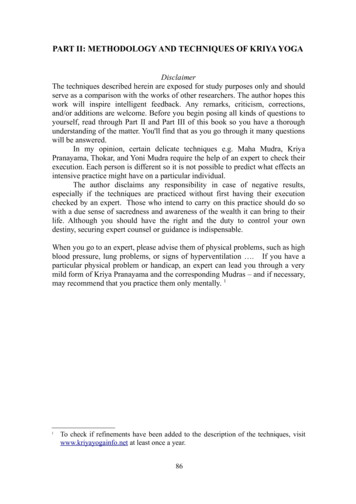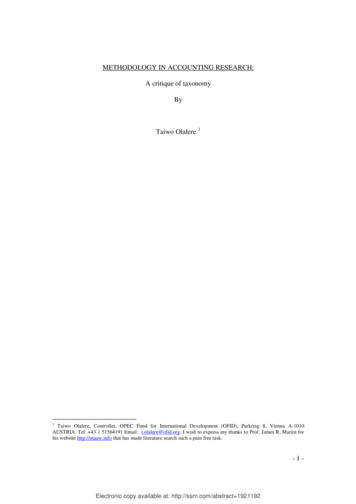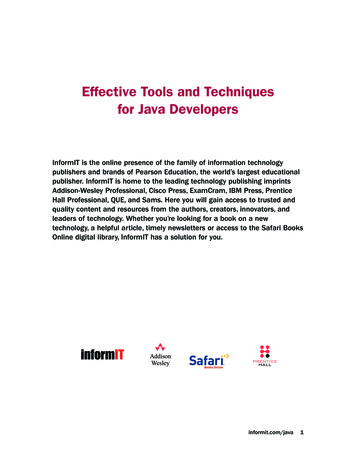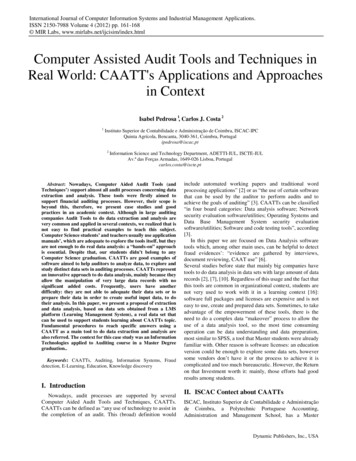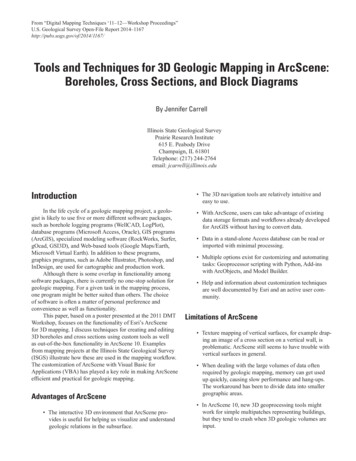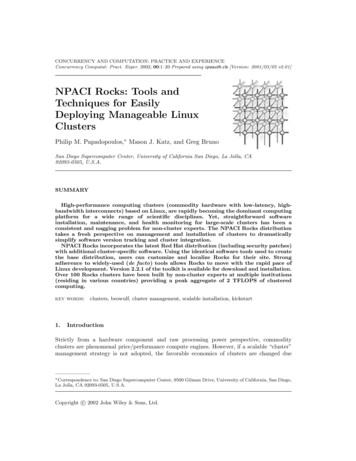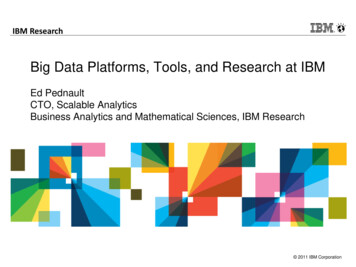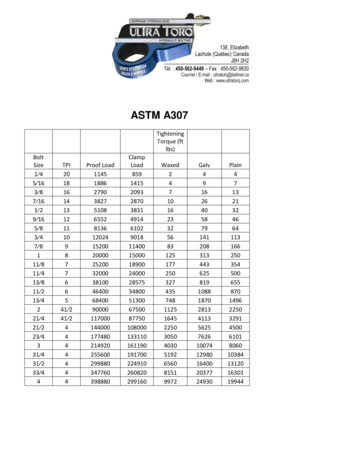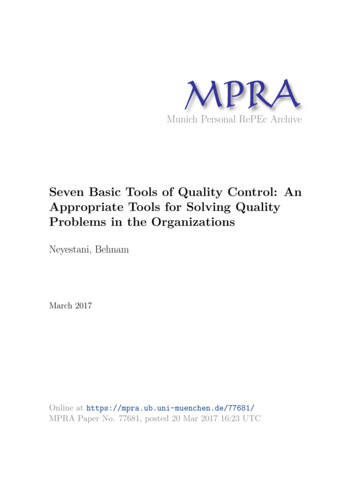
Transcription
RESEARCH METHODOLOGY:TOOLS AND TECHNIQUES1
RESEARCH METHODOLOGY: TOOLS AND TECHNIQUESDr. Prabhat PandeyDr. Meenu Mishra Pandey Bridge Center, 2015BRIDGE CENTERBuzau, Al. Marghiloman 245 bis, 120082Tel. 0728394546e-mail: editor@euacademic.orgRomania, European UnionPrinted in RomaniaFirst published, 2015ISBN 978-606-93502-7-0All rights reserved. No part of this publication may bereproduced or transmitted, in any form or by any means,without permission. Any person who does any unauthorisedact in relation to this publication may be liable to criminalprosecution and civil claims for damages.The publishers have applied for copyright permission forthose pieces that need copyright clearance and dueacknowledgement will be made at the first opportunity.The views and contents of this book are solely of the author.The author of the book has taken all reasonable care to ensurethat the contents of the book do not violate any existingcopyright or other intellectual property rights of any personin any manner whatsoever. In the event the author has beenunable to track any source and if any copyright has beeninadvertently infringed, please notify the publisher in writingfor corrective action.2
Dr. Prabhat PandeyDr. Meenu Mishra PandeyRESEARCH METHODOLOGY: TOOLSAND TECHNIQUESBridge Center20153
4
CONTENTSPreface .6Chapter 1 – Research .7Chapter 2 - Research Process 13Chapter 3 - Research Design .18Chapter 4 - Research Problem .23Chapter 5 - Variables and Their Types . .29Chapter 6 - Formulation of Hypothesis .32Chapter 7 – Sampling .40Chapter 8 - Tools of Data Collection 57Chapter 9 - Data Analysis .70Chapter 10 - Interpretation of Data .75Chapter 11 - Research Methods .78Chapter 12 - Descriptive or Survey Method .84Chapter 13 - Experimental Method .89Chapter 14 - Research Proposal .101Chapter 15 - Research Report . . 110Bibliography . .1165
PREFACEThe authors felt during their several years of teaching experience thatstudents fail to understand the books written on Research Methodologybecause generally they are written in technical language. Since thiscourse is not taught before the Master’s degree, the students are notfamiliar with its vocabulary, methodology and course contents.The authors have made an attempt to write it in very nontechnical language. It has been attempted that students who try tounderstand the research methodology through self-learning may alsofind it easy. The chapters are written with that approach. Even thosestudents who intend to attain high level of knowledge of the researchmethodology in social sciences will find this book very helpful inunderstanding the basic concepts before they read any book onresearch methodology.This book is useful those students who offer the ResearchMethodology at Post Graduation and M.Phil. Level. This book is alsovery useful for Ph.D. Course Work examinations.Dr. Prabhat PandeyDr. Meenu Mishra Pandey6
1ResearchIntroduction:Research is an essential and powerful tool in leading man towardsprogress. Without systematic research there would have been very littleprogress.John W. Best has rightly said, “The secret of our culturaldevelopment has been research, pushing back the areas of ignorance bydiscovering new truths, which, in turn, lead to better ways of doingthings and better products.”Scientific research leads to progress in some field of life. Newproducts, new facts, new concepts and new ways of doing things arebeing found due to ever-increasing significant research in the physical,the biological, the social and the psychological fields. Research today isno longer confined to the science laboratory.Meaning of Research:Word ‘Research’ is comprises of two words Re Search. It means tosearch again. So research means a systematic investigation or activity togain new knowledge of the already existing facts.Research is an intellectual activity. It is responsible for bringingto light new knowledge. It is also responsible for correcting the presentmistakes, removing existing misconceptions and adding new learning tothe existing fund of knowledge. Researches are considered as acombination of those activities which are removed from day to day life7
and are pursued by those persons who are gifted in intellect and sincerein pursuit of knowledge. But it is not correct to say that the research isrestricted to such type of persons, however, it is correct to say thatmajor contribution of research comes from highly gifted and committedworkers. Thus the research is not at all mysterious and is carried on byhundreds of thousands of average individuals.Research is also considered as the application of scientificmethod in solving the problems. It is a systematic, formal and intensiveprocess of carrying on the scientific method of analysis. There are manyways of obtaining knowledge. They are intuition, revelation, andauthority, logical manipulation of basic assumptions, informed guesses,observation, and reasoning by analogy. One of the branches of researchknown as empirical research is highly goal-oriented technique.Definitions of Research:The following are the important definitions of research:“Research is an endeavor / attempt to discover, develop and verifyknowledge. It is an intellectual process that has developed overhundreds of years ever changing in purpose and form and alwaysresearching to truth.”J. Francis Rummel“Research is an honest, exhaustive, intelligent searching for facts andtheir meanings or implications with reference to a given problem. Theproduct or findings of a given piece of research should be an authentic,verifiable contribution to knowledge in the field studied.”P.M. Cook“Research may be defined as a method of studying problems whosesolutions are to be derived partly or wholly from facts.”W.S. Monroes“Research is considered to be the more formal, systematic intensiveprocess of carrying on the scientific method of analysis. It involves a8
more systematic structure of investigation, usually resulting in somesort of formal record of procedures and a report of results orconclusion.”John W. Best“Research comprises defining and redefining problems ,formulatinghypothesis or suggested solutions, collecting ,organizing and evaluatingdata, making deductions and reaching conclusions and at last carefultesting the conclusions to determine whether they fit the formulatedhypothesis.”Clifford Woody“Research is a systematic effort to gain new knowledge.”Redman & Mori“Social research may be defined as a scientific undertaking which bymeans of logical and systematized techniques aims to discover newfacts or verify and test old facts , analyse their sequences , interrelationships and casual explanation which were derived within anappropriate theoretical frame of reference , develop new scientifictools , concepts and theories which would facilitate reliable and validstudy of human behavior.”P.V. YoungePurpose of Research:The purpose of research is to discover answers to questions through theapplication of scientific procedure. The main aim of research is to findout the truth which is hidden and which has not been discovered as yet.Though each research study has its own specific purpose, some generalobjectives of research below:(i) To gain familiarity with a phenomenon or to achieve new insightsinto it. (Studies with this object in view are termed as exploratory orformative research studies).9
(ii) To portray accurately the characteristics of a particular individual,situation or a group.(Studies with this object in view are known asdescriptive research studies).(iii) To determine the frequency with which something occurs or withwhich it is associated with something else. (Studies with this objectin view are known as diagnostic research studies).(iv) To test a hypothesis of a causal relationship between variables.(Such studies are known as hypothesis-testing research studies).Characteristics of Research:Following are the characteristics of research;(i)(ii)(iii)Research is directed toward the solution of a problem.Research requires expertise.Research emphasizes the development of generalizations,principles, or theories that will be helpful in predicting futureoccurrences.(iv) Research is based upon observable experience or empiricalevidences.(v) Research demands accurate observation and description.(vi) Research involves gathering new data from primary or first-handsources or using existing data for a new purpose.(vii) Research is characterized by carefully designed procedures thatapply rigorous analysis.(viii) Research involves the quest for answers to un-solved problems.(ix) Research strives to be objective and logical, applying everypossible test to validate the procedures employed the datacollected and the conclusions reached.(x) Research is characterized by patient and unhurried activity.(xi) Research is carefully recorded and collected.(xii) Research sometimes requires courage.10
Types of Research:There are varieties of ways through which we may classify it intodifferent categories.(A) On the basis of nature of information:On the basis of nature of information we can classify the research intotwo types;(i) Qualitative Research: When information is in the form of qualitativedata.(ii) Quantitative Research: When information is in the form ofquantitative data.(B) On the basis of utility of content or nature of subject matter ofresearch:On the basis of these criteria we can categorize the research into twocategories.(i) Basic/ Fundamental /pure or Theoretical Research: Its utility isuniversal.(ii) Experimental or Applied Research: Its utility is limited.(C) On the basis of approach of research:We may classify research into two different categories.(i) Longitudinal Research: Examples of this category are historical, Casestudy and Genetic research.(ii) Cross-Sectional Research: ExamplesExperimental and Survey Research.ofthiscategoryare(D) On the basis of method of research :On the basis of research method we may classify a research into fivedifferent categories.(i)Philosophical Research: It is purely qualitative in nature and we arefocusing on the vision of others on the content of research.(ii) Historical Research: It is both qualitative as well as quantitative innature and deals with past events.11
(iii) Survey Research: It deals with present events and is quantitative innature. It may further be sub-divided into; discretional, correlationaland exploratory type of research.(iv) Experimental Research: This is purely quantitative in nature anddeals with future events.(v) Case-Study Research: It deals with unusual events. It may bequalitative as well as quantitative in nature depending upon thecontent.12
2Research ProcessResearch process consists of series of actions or steps necessary toeffectively carry out research. These actions or steps are;(i)Formulating the Research Problem(ii)Extensive Literature Survey(iii)Developing the Research Hypothesis(iv)Preparing the Research Design(v)Determining the Research Design(vi)Collecting the Research Data(vii) Execution of the Project(viii) Analysis of Data(ix)Hypothesis Testing(x)Generalization and Interpretation(xi)Preparing of the Report or Presentation of the Result(i) Formulation of Research Problem:At the very outset, the researcher must decide the general area ofinterest or aspect of a subject matter that he would like to inquire intoand then research problem should be formulated.(ii) Extensive Literature Survey:Once the problem is formulated the researcher should undertakeextensive literature survey connected with the problem. For thispurpose, the abstracting and indexing journals and published or13
unpublished bibliographies are the first place to go to academicjournals, conference proceedings, government reports, books etc. mustbe tapped depending on the nature of the problem.(iii) Development of Working Hypothesis:After extensive literature survey, researcher should state in clear termsthe working hypothesis or hypotheses. Working hypothesis is tentativeassumption made in order to draw out and test its logical or empiricalconsequences. It’s very important or it provides the focal point forresearch.(iv) Preparing the Research Design:After framing hypothesis we have to prepare a research design i.e. wehave to state the conceptual structure within which research would beconducted. The preparation of such a design facilitates research to be asefficient as possible yielding maximal information. In other words, thefunction of research design is to provide for the collection of relevantevidence with optimum effort, time and expenditure. But how all thesecan be achieved depends mainly on the research purpose.(v) Determining Sample Design:A sample design is a definite plan determined before any data is actuallycollected for obtaining a sample from a given population.in censusinquiry we involve a great deal of time, money and energy so it it notpossible in practice under many circumstances. Sample designs can beeither probability or non-probability. With probability samples eachelement has a known probability of being included in the sample butthe non-probability samples do not allow the researchers to determinethis probability.14
(vi) Collecting the Data:There are several ways of collecting the appropriate data which differconsiderably in context of cost, time and other resources at the disposalof the researcher. Primary data can be collected either throughexperiment or through survey. In case of survey, data can be collectedby any one or more of the following ways;By observation, Through personal interview, Through telephonic interviews, By mailing of questionnaires or Through schedules.(vii) Execution of the Project:Execution of project is a very important step in the research process. Ifthe execution of the project proceeds on correct lines, the data to becollected would be adequate and dependable .A careful watch shouldbe kept for unanticipated factors in order to keep the survey realistic asmuch as possible.(viii) Analysis of Data:The analysis of data requires a number of closely related operationssuch as establishment of categories, the application of these categoriesto raw data through coding, tabulation and then drawing statisticalinference. Analysis work after tabulation is generally based on thecomputation of various percentages; coefficients etc., by applyingvarious well defined statistical formulae. In the process of analysis,relationships of differences supporting or conflicting with original ornew hypothesis should be subjected to tests of significance todetermine with what validity data can be said to indicate anyconclusions.15
(ix) Hypothesis Testing:After analyzing the data, the researcher is in a position to test thehypothesis, if any, he had formulated earlier. Do the facts support thehypothesis or they happen to be contrary? This is the usual questionwhich is to be answered by applying various tests like ‘t’ test, ’F’ testetc. F test have been developed by statisticians for the purpose.Hypothesis testing will result in either accepting the hypothesis or inrejecting it. If the researcher had no hypothesis to start with,generalizations established on the basis of data may be stated.(x) Generalizations and Interpretation:If a hypothesis is tested and upheld several times, it may be possible forthe researcher to arrive at generalization i.e. to build a theory. As amatter of fact, the real value of research lies in its ability to arrive atcertain generalizations. If the researcher had no hypothesis to startwith, he might seek to explain his findings on the basis of some theory.It is known as interpretation.(xi) Preparation of the Report or the Thesis:Finally, the researcher has to prepare the report of what has been doneby him. The layout of the report should be as follows; the preliminarypages, the main text and end matter. The preliminary pages carry title,acknowledgements and forward and then index. The main text of thereport should have introduction, review of literature and methodology.Criteria of Good Research:One expects scientific research to satisfy the following criteria:(a) The purpose of the research should be clearly defined and commonconcepts be used.16
(b) The research procedure used should be described in sufficient detailto permit another researcher to repeat the researcher for furtheradvancement, keeping the continuity of what has already beenattained.(c) The procedural design of the research should be carefully plannedto yield results that are as objective as possible.(d) The researcher should report with complete frankness, flaws inprocedural design and estimate their effects upon the findings.(e) The analysis of data should be sufficiently adequate to reveal itssignificance and the methods of analysis used should beappropriate. The validity and reliability of the data should bechecked carefully.(f) Conclusions should be confined to those justified by the data of theresearch and limited to those for which the data provide anadequate basis.(g) Greater confidence in research is warranted if the researcher isexperienced, has a good reputation in research and is a person ofintegrity.17
3Research DesignA research design is simply the framework or plan for a study that isused as a guide in collecting and analyzing the data. It is a blueprint thatis followed in completing a study. Research design is the blue print forcollection measurement and analysis of data. Actually it is a map that isusually developed to guide the research.Definitions:“Research design is a master plan specifying the methods andprocedures for collection and analyzing the needed information.”William Zikmund“Research design is the plan, structure and strategy of investigationconceived so as to obtain answers to research questions and to controlvariance.”KerlingerThus we can say that a research design is the arrangement of conditionfor collection and analysis of data in a manner that aims to generalizethe findings of the sample on the population.Purpose of a Research Design:Research designs are used for the following purposes;(i) To minimize the expenditure:Research design carries an important influence on the reliability of theresults attained .It therefore provides a solid base for the wholeresearch. This makes the research as effective as possible by providing18
maximum information with minimum spending of effort, money andtime by preparing the advance plan of all about the research.(ii) To facilitate the smooth scaling:Research design is needed because it facilitates the smooth scaling ofthe various research operations, thereby making research as efficient aspossible yielding maximal information with minimal expenditure ofeffort, time and money.(iii) To collect the relevant data and technique:Research design stands for advance planning of the methods to beadopted for collecting the relevant data and the techniques to be usedin their analysis, keeping in view the objective of the research and theavailability of staff time and money. Poor preparation of research designupset the entire project.(iv) To provide blue print for plans:Research design is needed due to the fact that it allows for the smoothworking of many research operations. It is like blue print which we needin advance to plan the methods to be adopted for collecting therelevant data and techniques to be used in its analysis for preparation ofresearch project. Just as for better economical and attractiveconstruction of a house need a blue print and a map of that, similarlywe needs a blue print or a design for the smooth flow of operatio
7 Research Introduction: Research is an essential and powerful tool in leading man towards progress. Without systematic research there would have been very little
